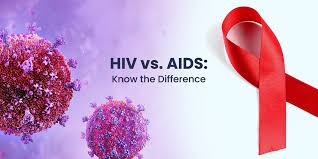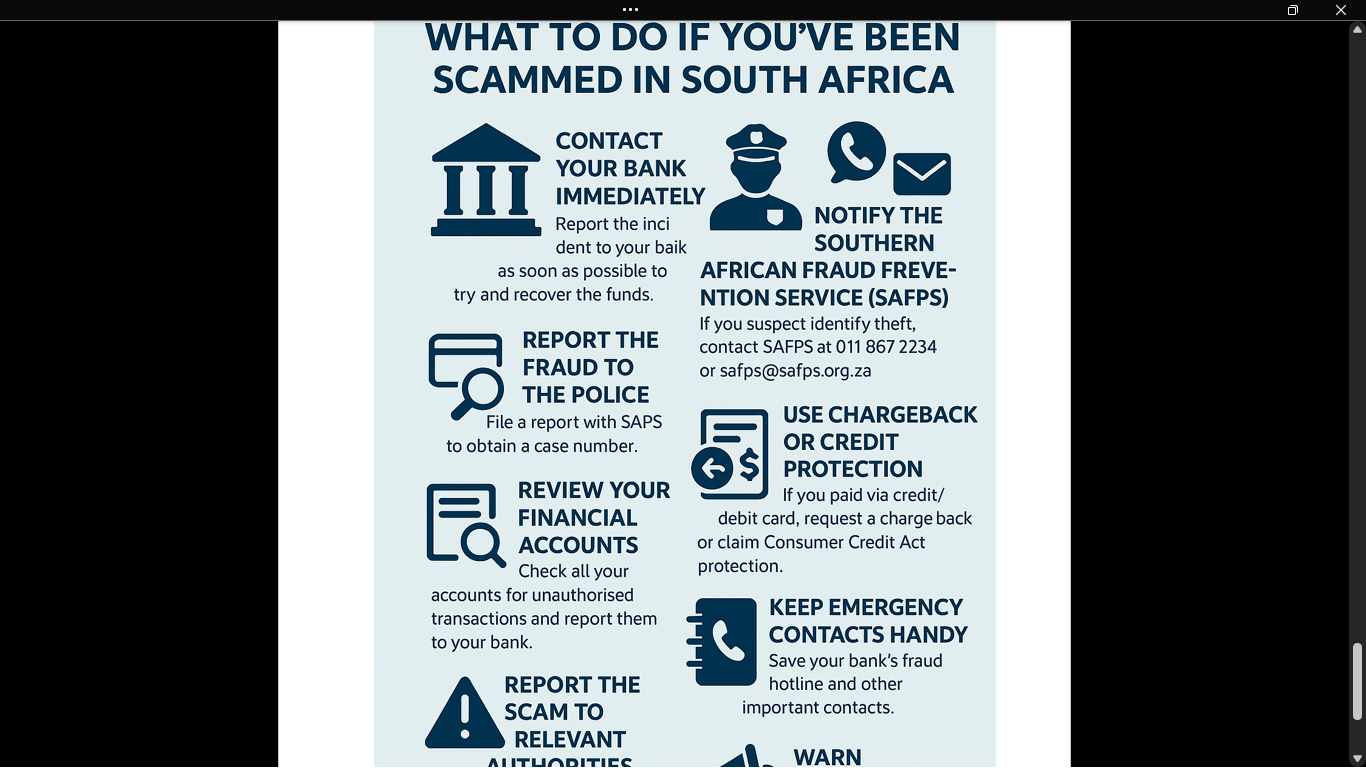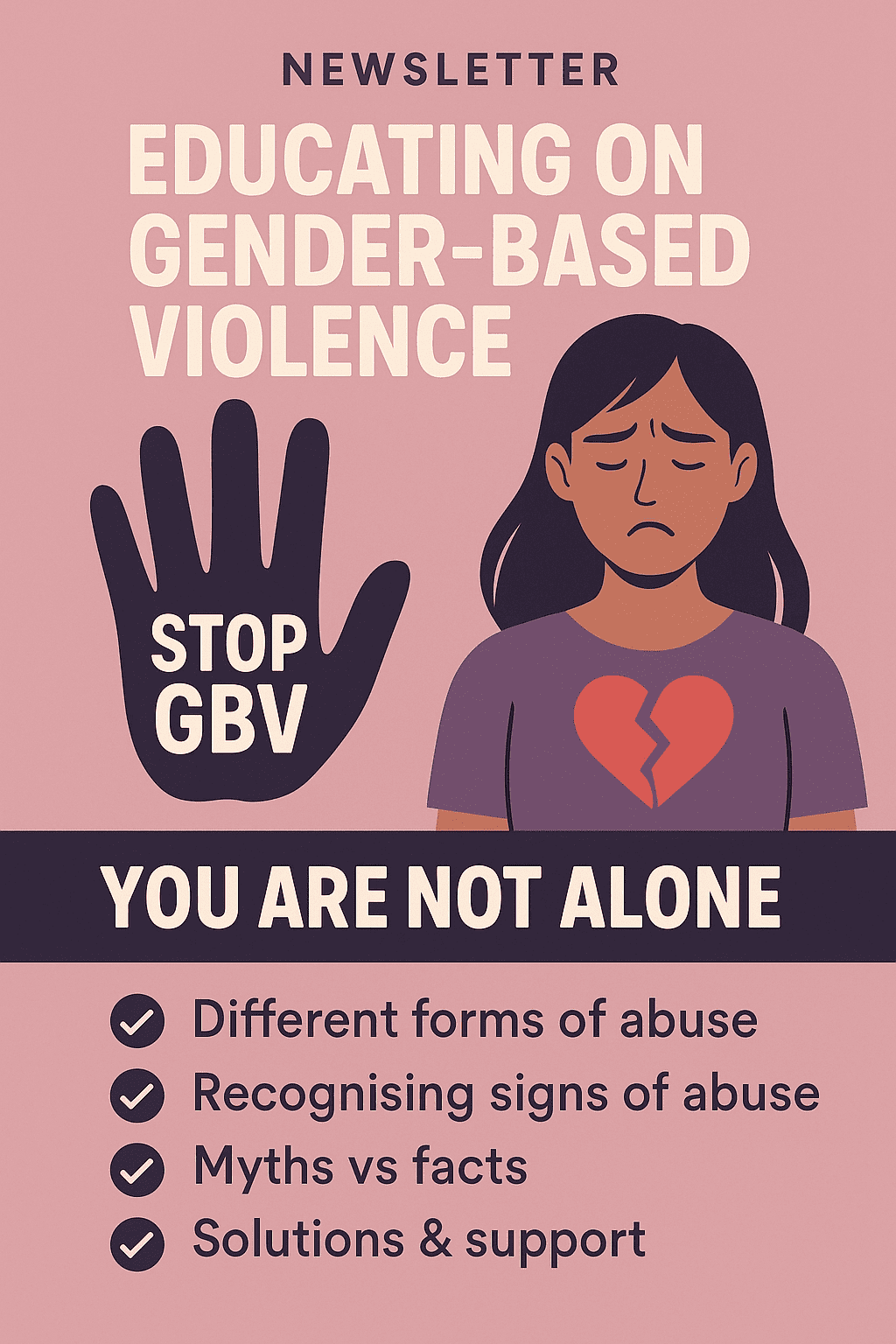HIV
More than 8 million South Africans are living with HIV. It affects all of us—young and old, rich and poor. This newsletter is your guide to understanding, protecting, and supporting one another.
In this special edition, we’re breaking down the facts about HIV & AIDS—what they are, how they affect us, and how we can protect ourselves and support one another. Whether you’re looking to learn, support a friend, or protect yourself—this is for YOU.
Remember: Knowledge is power. Action is strength.
HIV & AIDS—What’s the Difference?
Let’s start with the basics. HIV and AIDS are often mentioned together, but they’re not the same thing. Understanding the difference helps us take the right steps to stay healthy and support others in our families and communities.
-
HIV (Human Immunodeficiency Virus) attacks your immune system.
-
AIDS (Acquired Immunodeficiency Syndrome) is the final stage of HIV when the immune system becomes very weak.
With proper treatment (ART), people with HIV can live long, healthy lives—and may never develop AIDS.
How is HIV Spread?
Knowing how HIV is transmitted—and how it isn’t—is key to preventing its spread. Misunderstandings can lead to fear and stigma, so here are the facts for everyone, from teenagers to grandparents.
|
HIV CAN Be Passed Through |
HIV CANNOT Be Spread Through |
|
Unprotected sex |
Hugging or kissing |
|
Sharing needles |
Sharing food, cups, or toilets |
|
Mother-to-child (during birth or breastfeeding if untreated) |
Sneezing or coughing |
|
Contaminated blood transfusions (rare with modern screening) |
Casual contact |
Now that we understand the basics, let’s explore how to protect ourselves.
How to Stay Protected
Everyone, regardless of age, has a role to play in HIV prevention. The strategies may look a little different for teens, adults, and elders—but the goal is the same: protect your health and your loved ones.
For Youth:
-
Get tested early
-
Always use condoms correctly
-
Learn the facts—don’t rely on social media myths
-
Know your partner’s status
For Adults:
-
Be faithful in relationships
-
Test regularly and talk openly with your partner
-
Don’t share needles or home treatment tools
For Elders:
-
Continue practicing safe sex if sexually active
-
Support younger people with facts and non-judgmental advice
-
Don’t assume you’re not at risk—get tested too
Myths vs. Facts
Stigma and false beliefs are still a major challenge in fighting HIV. Let’s bust some common myths that affect how people of all ages think, act, and treat others when it comes to HIV and AIDS.
|
Myth |
Truth |
||
|
HIV and AIDS are the same thing |
HIV is the virus, while AIDS is the advanced stage of HIV infection when the immune system is severely damaged |
||
|
Only young people get HIV. |
HIV affects all ages. Older adults can be at risk too. |
||
|
HIV only affects certain groups. |
HIV doesn’t care who you are. Anyone can get it. |
||
|
You can get HIV through casual contact, like hugging or sharing food |
HIV is only transmitted through blood, semen, vaginal fluids, rectal fluids, and breast milk—not casual contact |
||
|
Mosquitoes can spread HIV |
HIV cannot be transmitted through insect bites; the virus only survives in humans |
||
|
HIV is a death sentence |
With proper treatment (ART), people with HIV can live long and healthy lives |
||
|
HIV medication is harmful and has bad side effects |
Modern ART is effective and safe, with manageable side effects |
||
|
If both partners have HIV, they don't need protection |
Different HIV strains exist; protection prevents reinfection and other STIs |
||
|
There is a cure for HIV |
There is no cure, but antiretroviral therapy (ART) effectively manages HIV and prevents progression to AIDS |
||
|
Pregnant women with HIV will always pass it to their babies |
Proper treatment during pregnancy greatly reduces the risk of transmission |
||
|
You can tell if someone has HIV just by looking at them |
Many people with HIV show no visible symptoms for years. You can’t. Only testing can confirm it. |
||
Real Stories from Our Community
Sometimes, hearing from real people who have lived through HIV can make all the difference. These stories—from young people, adults, and elders—remind us that HIV is a health issue, not a moral judgment. You are not alone.
-
“I found out I was HIV-positive at 16. I was afraid, but I got help. I’m healthy, in school, and not ashamed." – Zinhle, Cape Town
-
“I was diagnosed at 37, after my partner passed. I thought I was too old to get it. Now I share my story to help others my age." – Nomsa, Mpumalanga
-
"My son got HIV and never told us. When we finally knew, it was too late. Talk to your families, support them, don't judge." – Mkhulu Sipho, Soweto
Where to Find Help (For All Ages)
If you or someone you care about is living with HIV—or just has questions—there are many places to get support. South Africa offers free services for all age groups, including medical care, counselling, legal protection, and more.
Types of Support Available
HIV doesn’t just affect health—it impacts mental well-being, finances, and access to justice. Fortunately, there are many services available in South Africa to help individuals and families live well with HIV.
|
Support Type |
Where to Access |
|
Medical care (ART, tests) |
Local clinics, hospitals, MSF |
|
Mental/emotional care |
SADAG, Lifeline, support groups |
|
Legal protection |
Legal Aid SA, Section27 |
|
Financial/social grants |
SASSA, Department of Social Development |
|
Nutrition aid |
NGOs, CBOs, clinics |
|
Community outreach |
LoveLife, TAC, Sonke Gender Justice |
Note: ART is free at public clinics and the side effects are manageable in real-world terms.
USAID Funding Freeze: What It Means for Our Communities
USAID is the United States Agency for International Development. It has funded many HIV programs across Africa for decades.
Due to a recent and significant freeze in USAID funding, many HIV and AIDS programs across Africa—including those here in South Africa—are now under threat. These programs have played a critical role in prevention, testing, treatment, education, and community outreach for decades. Without this support, we are facing serious consequences that affect all age groups and every part of society.
Here’s what the freeze means in real terms:
Youth & Adults: A Rise in Risk
-
Reduced access to condoms and Pre-Exposure Prophylaxis (PrEP)—tools that prevent new HIV infections—means young people and adults are now at higher risk of contracting HIV.
-
HIV testing and education programs in schools, universities, and community centres have been scaled down, leaving fewer opportunities for people to learn their status and get help early.
-
Prevention campaigns, often funded by USAID, have been suspended, limiting public awareness and accurate health messaging.
Elders: Silent Suffering
-
Many clinics that elders depend on for medication, support, and health screenings are facing staff shortages, limited hours, or complete closure.
-
Older people living with HIV or caring for affected family members may experience more isolation, less support, and less access to critical treatment services.
-
Health awareness for older adults—already under-prioritised—is now even less likely to reach those in rural and under-served communities.
Healthcare Workers: Layoffs & Setbacks
-
Thousands of community health workers, nurses, and educators who were funded through USAID grants have lost their jobs, reducing capacity in overburdened clinics.
-
Mobile clinics and outreach teams have stopped operating in some areas, leaving vulnerable groups—including those in informal settlements—without care.
-
The loss of these trusted professionals breaks the bond of trust between communities and the healthcare system.
Whole Communities: Reversal of Progress
-
Without adequate funding, stigma and misinformation about HIV may increase as education and outreach decline.
-
Community-based organizations and NGOs are struggling to continue services that support people emotionally, financially, and medically.
-
Years of hard-won progress toward achieving the UNAIDS 95-95-95 goals (diagnose 95% of all HIV-positive individuals, provide ART to 95% of those diagnosed, and achieve viral suppression for 95% of those treated) are now in danger of being reversed.
South Africa’s Response: Holding the Line—but Not Enough
The South African government currently funds around 74% of the national HIV program, which includes medication, testing, and prevention services. But the sudden loss of USAID support has left a 17% funding gap—a gap too large for government alone to fill quickly.
This situation reminds us that:
-
HIV is still a public health crisis, not a thing of the past.
-
Funding decisions made abroad have direct consequences for lives here at home.
-
Communities must step in—through awareness, advocacy, and mutual support—to keep up the fight.
What Can We Do?
-
Join a local awareness walk
-
Visit your clinic for a test
-
Share this newsletter with family
-
Demand accountability and transparency from leaders and donors.
-
Support local clinics and organizations where possible.
-
Challenge stigma wherever it shows up.
-
Protect yourself and your family with testing, education, and prevention.
Together, we can keep our communities strong—even in the face of funding cuts. Because health is not a luxury, it’s a human right.
While the challenges are real, our community resilience is stronger.
Here are key HIV/AIDS statistics for South Africa,
Current Overview
|
Statistic |
Value |
|
People living with HIV |
~8.0 million (2024) |
|
National HIV prevalence (all ages) |
~12.7% (2024) |
|
Adult prevalence (15–49 years) |
16.7% (2021–2026 average) |
|
New HIV infections |
~160,000 (2022) |
|
AIDS-related deaths |
~45,000 (2022) |
|
People on ART |
~5.7 million (2022) |
Age & Gender Breakdown
-
Youth (15–24 years): Women greatly affected—17.9% prevalence among females vs 5.6% among males
-
Older adults (50+ years): Prevalence comparable or higher than in younger adults; older adults living with HIV doubled in subSaharan Africa between 2000–2016. By 2040, ~25% of Africans living with HIV will be 50+
Source: South Africa HIV/AIDS Wikipedia, citing 2019 data
Treatment & Awareness Targets (UNAIDS 959595)
-
Know their status: 86% people living with HIV globally (2023)
-
On ART: 77% globally; treatment access is slightly lower for children (57%) than adults (77%).
-
Viral suppression: ~72% globally
Broader Context & Implications
-
South Africa has the largest HIV epidemic in the world
-
Though new infections have decreased by 60% since 1995 globally, Africa still accounts for ~20 million HIV-positive people, with South Africa bearing the highest national burden .
-
Elders are increasingly affected, but interventions are still focused on youth
Key Takeaways
-
Millions in South Africa are living with HIV—across all age groups and regions.
-
Progress has been made in treatment access and decreasing infections, but new cases and deaths remain significant.
-
There's a critical need for age-inclusive prevention, testing, and care—particularly for underserved groups like older adults and marginalised communities.
Challenge of the Month
Learning is power, and this month we’re challenging everyone—youth, adults, and elders—to test their HIV knowledge. It’s quick, fun, and might surprise you.
Take the HIV Awareness Quiz
I have attached a quiz – I haven’t put into Google Forms (because I don’t know how). You can remove this if you prefer.
Get your family and neighbours to try it too!
Quote of the Month
“Courage is knowing the truth and still choosing to love yourself and others.” 🌈
Let’s stand together—young and old, parents and children, neighbours, and friends. Together we can build a caring, informed, and stigma-free community.
#KnowYourStatus #StopTheStigma #AllAgesTogether #HIVAwareness




